
Mars Attacks is a science fiction-themed trading card series released in 1962 by Topps. The cards feature artwork by science fiction artists Wally Wood and Norman Saunders. The cards form a story arc, which tells of the invasion of Earth by cruel, hideous Martians under the command of a corrupt Martian government who conceal the fact from the Martian populace that Mars is doomed to explode and, therefore, proposes colonization of Earth to turn it into their new homeworld. The cards depict futuristic battle scenes and bizarre methods of Martian attack, torture and slaughter of humans, as well as various Earth nations being attacked. The story concludes with an expeditionary force of humans volunteering to embark on a counterattack on Mars, in which the Earth force attacks the Martians in their manner. This necessitates the Martians that are still on Mars to defend their homeworld. The Earth attack forces, after destroying the Martian cities and killing the Martians, depart just before Mars is destroyed in the predicted cataclysm, thus ensuring the peace and safety of Earth as the Martian race is seemingly doomed to extinction.

The PC-FX is a 32-bit home video game console developed by NEC and Hudson Soft. It was released in 1994 and discontinued in February 1998, as NEC's final home video game console. Based on the NEC V810 CPU and CD-ROM, it was intended as the successor to the PC Engine. Unlike its predecessor, the PC-FX was only released in Japan.

The TurboGrafx-16, known as the PC Engine outside North America, is a home video game console designed by Hudson Soft and sold by NEC Home Electronics. It was the first console marketed in the fourth generation, commonly known as the 16-bit era, though the console has an 8-bit central processing unit (CPU) coupled with a 16-bit graphics processor. It was released in Japan in 1987 and in North America in 1989. In Europe the Japanese model was unofficially imported and distributed in the United Kingdom and France from 1988. In Japan, the system was launched as a competitor to the Famicom, but the delayed United States release meant that it ended up competing with the Sega Genesis and later the Super NES.

Elite is a space trading video game. It was written and developed by David Braben and Ian Bell and originally published by Acornsoft for the BBC Micro and Acorn Electron computers in September 1984. Elite's open-ended game model, and revolutionary 3D graphics led to it being ported to virtually every contemporary home computer system and earned it a place as a classic and a genre maker in gaming history. The game's title derives from one of the player's goals of raising their combat rating to the exalted heights of "Elite".

Non-sport trading cards are a particular kind of collectible card designated as such because trading cards have historically prominently featured athletes from the world of sports as subjects. Non-sports cards are trading cards whose subjects can be virtually anything other than sports-themed.

The Star Trek Customizable Card Game is an out-of-print collectible card game based on the Star Trek universe. The name is commonly abbreviated as STCCG or ST:CCG. It was first introduced in 1994 by Decipher, Inc., under the name Star Trek: The Next Generation Customizable Card Game. The game now has two distinct editions, though both forms of the game have many common elements.
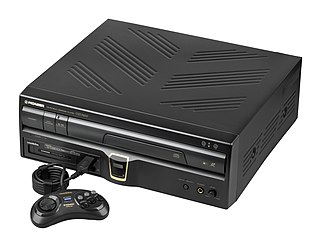
The LaserActive is a converged device and fourth-generation home video game console capable of playing LaserDiscs, Compact Discs, console games, and LD-G karaoke discs. It was released by Pioneer Corporation in 1993. In addition to LaserActive games, separately sold add-on modules accept Mega Drive/Genesis and PC Engine/TurboGrafx-16 ROM cartridges and CD-ROMs.
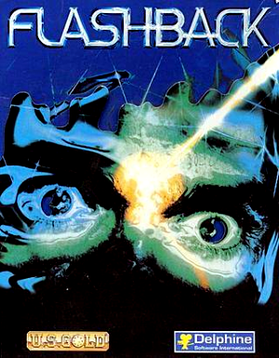
Flashback, released as Flashback: The Quest for Identity in the United States, is a 1992 science fiction cinematic platform game developed by Delphine Software of France and published by U.S. Gold in the United States and Europe, and Sunsoft in Japan.
Gerald Brom, known professionally as Brom, is an American gothic fantasy artist and illustrator, known for his work in role-playing games, novels, and comics.
"Remember Me" is the 79th episode of the syndicated American science-fiction television series Star Trek: The Next Generation, the fifth episode of the fourth season.
The long-running British science fiction television series Doctor Who has since its beginnings in 1963 generated many hundreds of products related to the show, from toys and games to picture cards and postage stamps. This article is not an exhaustive list of merchandise but attempts to present a flavour of the type of material that has been produced. This entry mainly concentrates on "official" spin-offs, that is to say, material sanctioned by the British Broadcasting Corporation, which produces the series.

Intellivision Lives! is a compilation of over 60 Intellivision video games, originally produced by Mattel Electronics and INTV Corporation between 1978 and 1990. Using original game code and software emulation, Intellivision Productions released the compilation on a Windows and Macintosh hybrid CD-ROM in December 1998. Additional versions were then released for the PlayStation 2, Xbox, and GameCube by Crave Entertainment. In 2010, Virtual Play Games released a Nintendo DS version.
SkyBox International Inc., formerly Impel Marketing, was an American trading card manufacturing company based in Durham, North Carolina started in 1990 and operated until 1995.
FX Fighter is a series of video games developed by Argonaut Software and published by GTE Entertainment. The two games in the series are FX Fighter (1995) for DOS CD-ROM and FX Fighter Turbo (1996) for Windows 95.

On The Edge is an out-of-print collectible card game released in 1994, not long after Magic: The Gathering. The setting and characters were based on the RPG titled Over the Edge. The game's story was set on an island in the southern Mediterranean called Al Amarja, where various factions were fighting for control.
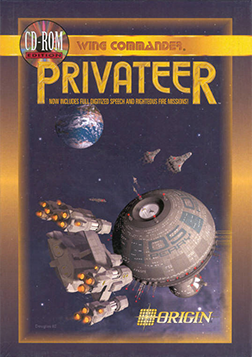
Wing Commander: Privateer is an adventure space trading and combat simulator computer game released by Origin Systems in September 1993. Privateer and its storyline is part of the Wing Commander series. The player takes the role of Grayson Burrows, a "privateer" who travels through the Gemini Sector, one of many sectors in the Wing Commander universe. Unlike Wing Commander, the player is no longer a navy pilot, but a freelancer who can choose to be a pirate, a merchant, a mercenary or any of the above in some combination. The player may follow the built-in plot but is free to adventure on his own, even after the plot has been completed.
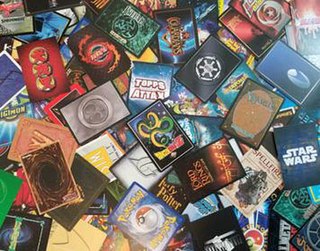
A collectible card game (CCG), also called a trading card game (TCG) among other names, is a type of card game that mixes strategic deck building elements with features of trading cards. It was introduced with Magic: The Gathering in 1993.
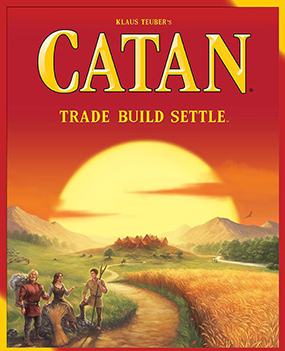
Catan, previously known as The Settlers of Catan or simply Settlers, is a multiplayer board game designed by Klaus Teuber. It was first published in 1995 in Germany by Franckh-Kosmos Verlag (Kosmos) as Die Siedler von Catan. Players take on the roles of settlers, each attempting to build and develop holdings while trading and acquiring resources. Players gain victory points as their settlements grow and the first to reach a set number of victory points, typically 10, wins. The game and its many expansions are also published by Catan Studio, Filosofia, GP, Inc., 999 Games, Κάισσα (Káissa), and Devir. Upon its release, The Settlers of Catan became one of the first Eurogames to achieve popularity outside Europe. As of 2020, more than 32 million copies in 40 languages had been sold.

Star Trek Maps is a reference work demonstrating the stellar cartography and navigation system featured on the Star Trek television series, written from an in-universe perspective. It was published by Bantam Books in August 1980, and licensed by Paramount Pictures.














